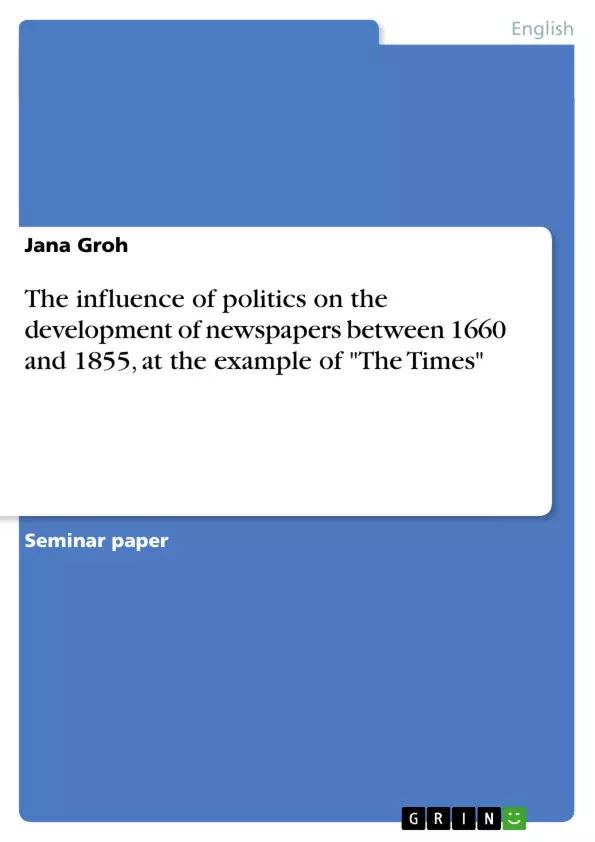Nowadays, there is a wide range of different newspapers, and most people see them as an important part of their everyday life. But newspapers as we know them today have only come into existence about three-hundred and fifty years ago. And although the liberty of the press at least in the countries of the European Union is today highly appraised, this has not always been the case. For a long time newspapers were a thorn in the flesh of governments, which thought that printed oppositional opinions threatened them. Therefore the governments tried to control newspapers tightly by enacting consequential laws. For years politics thus determined the development of newspapers.
This term paper wants to deal with the influence of the English government on the development of newspapers between 1660 and 1855. This relates to London newspapers, if not stated otherwise. Also, the term newspaper is used for the printed product, the company or the owner, resp., and the journalists, if not stated otherwise. The term is also used for news printed before 1670, even though the term itself only occured in the English language during that year.
After explaining prerequisites that were necessary for the emergence of modern newspapers in the first place, I will shortly look at the formation of newspapers before 1660, before I have a close look at laws established by the English government between 1662 and 1843. Then, I am going to compare selected parameters concerning the development of newspapers in different centuries. In the practical part I will analyse eight issues of The Times. I therefore chose the first January issues of a year, published with a time lag of ten years in each case.
In this term paper I want to analyse how the English government influenced the development of newspapers, which consequences this influence had, and how these again showed up in the newspapers themselves. Several things were necessary for the development of modern newspapers. About 3,500 BC the Sumerians developed writing. Only through writing disciplines like education, literature, and science, as well as trade and commerce could emerge or take place in a broader sphere. While the Sumerians wrote on, or rather carved clay tablets, the Egyptians used papyrus reeds from around 2,200 BC onwards. Compared to other materials like clay, stone and wood, papyrus had the great advantage to write something spontaneously and fast, and to be transported easily because of its light weight.
Inhaltsverzeichnis (Table of Contents)
- INTRODUCTION
- PREREQUISITES
- NEWSPAPERS BEFORE 1662
- POLITICAL ACTS CONCERNING NEWSPAPERS
- Licensing acts
- Tax laws
- Libel acts
- Summary
- COMPARISON OF SELECTED PARAMETERS
- THE LONDON TIMES
- History
- Comparison of chosen The Times issues
- Issue of the 1 January, 1785
- Issue of the 1 January, 1795
- Issue of the 1 January, 1805
- Issue of the 2 January, 1815
- Issue of the 1 January, 1825
- Issue of the 1 January, 1835
- Issue of the 1 January, 1845
- Issue of the 1 January, 1855
- Summary
- CONCLUSION
Zielsetzung und Themenschwerpunkte (Objectives and Key Themes)
This term paper investigates the influence of the English government on the development of newspapers between 1660 and 1855, focusing on London newspapers. The paper explores how political acts, including licensing acts, tax laws, and libel acts, shaped the evolution of newspapers during this period. The study also analyzes the development of The Times, comparing selected issues from different decades. The main objective is to understand the interplay between political power and the press in shaping the newspaper landscape of England.
- The influence of political acts on the development of newspapers in England
- The impact of licensing acts, tax laws, and libel acts on the press
- The evolution of newspaper content and structure over time
- The role of The Times in reflecting the political and social landscape of England
- The consequences of governmental influence on newspapers and their impact on the public
Zusammenfassung der Kapitel (Chapter Summaries)
- Introduction: This chapter introduces the topic of the term paper, outlining the historical context of newspapers and their relationship with governments. It highlights the importance of examining the influence of politics on the development of newspapers, particularly in England between 1660 and 1855.
- Prerequisites: This chapter explores the historical advancements that paved the way for the emergence of modern newspapers, including the development of writing, paper, printing technology, and communication infrastructure.
- Newspapers before 1662: This chapter delves into the early forms of newspapers, from handwritten notices to printed pamphlets and newsbooks. It analyzes the evolution of news content and distribution methods before the emergence of modern newspapers.
- Political Acts Concerning Newspapers: This chapter examines the legal framework established by the English government to regulate newspapers. It analyzes the impact of licensing acts, tax laws, and libel acts on the press and its development.
- Comparison of Selected Parameters: This chapter compares the evolution of newspapers over different centuries, highlighting the impact of political and social changes on their content and structure.
- The London Times: This chapter provides a historical overview of The Times, a prominent London newspaper, and analyzes selected issues from different decades. It examines the newspaper's content, style, and its reflection of the changing political and social landscape.
Schlüsselwörter (Keywords)
This term paper focuses on the influence of politics on the development of newspapers in England between 1660 and 1855. Key topics include licensing acts, tax laws, libel acts, the liberty of the press, the development of The Times, and the relationship between government and media.
- Citation du texte
- Jana Groh (Auteur), 2008, The influence of politics on the development of newspapers between 1660 and 1855, at the example of "The Times", Munich, GRIN Verlag, https://www.grin.com/document/90965



